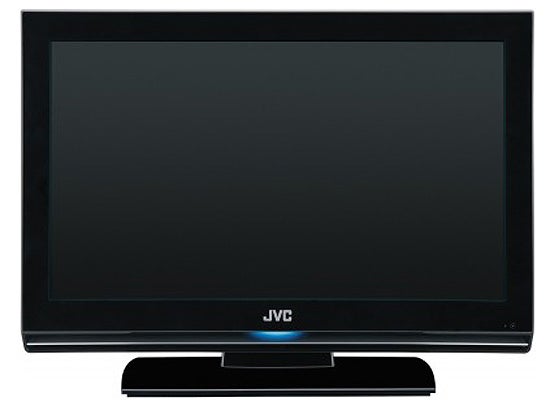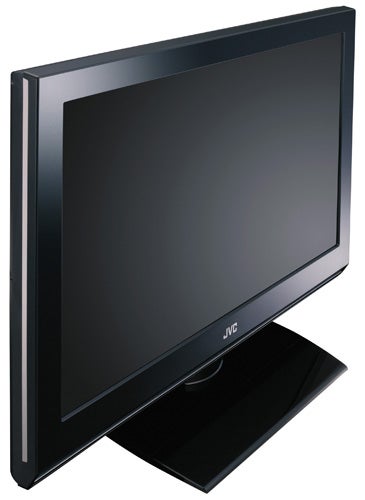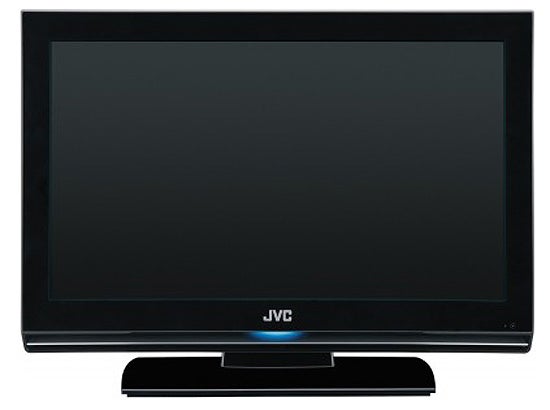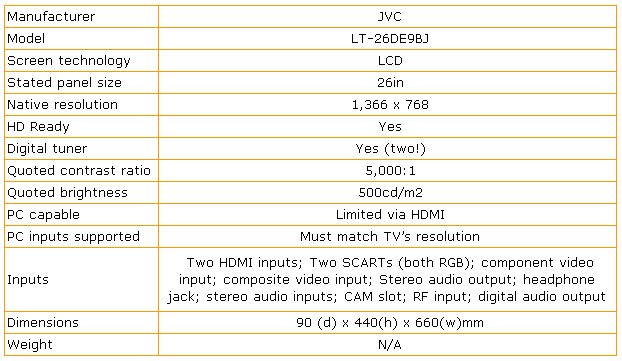JVC LT-26DE9BJ 26in LCD TV / PVR Review
JVC LT-26DE9BJ 26in LCD TV / PVR
JVC fits a PVR into an LCD TV again but this time it's a 26in one.

Verdict
Key Specifications
- Review Price: £465.49
As the nation’s disposable income disappears with alarming rapidity down the economic toilet, manufacturers suddenly appear much keener to push the smaller things in AV life. For suddenly, after a seemingly endless deluge of 40in+ TVs, I find myself in the company of the second 26in TV in consecutive TV reviews: JVC’s LT-26DE9BJ.
What’s more, the 26DE9BJ reinforces just how seriously manufacturers are suddenly taking this smaller screen size by being considerably more than just a 26in LCD TV. For tucked inside its little body is the small matter of a 160GB hard disk drive onto which you can record Freeview broadcasts without the need for the usual external set-top box.
What’s more, the recording capabilities we’re talking about here are no ordinary HD recording capabilities. Rather they’re implemented to the standard demanded by Freeview if a recorder is to earn itself ‘Freeview+’ accreditation.
For those of you not familiar with the Freeview+ standard, it has seven main tenets, which stack up rather like this:
1. At least an 8-day Electronic Programme Guide.
2. Series Link support allowing one timer to record an entire series.
3. The facility to record split programmes such as movies interrupted by a news broadcast as if they were one programme.
4. The ability to offer to record related programmes.
5. The ability to spot and record an alternative showing of a broadcast if there is a time conflict.
6. The ability to update schedule changes even while a TV is in standby.
7. Accurate recording’, whereby programmes are recorded based on data from a broadcaster rather than simple time settings.
All this clutter-busting, built-in recorder talk sounds like a very good idea on a 26in TV. After all, these days a 26in LCD TV is likely to find itself tucked away in a bedroom or second sitting room, where space is more limited and additional kit less bearable than in a typical living room.
Yet more good news finds the 26DE9BJ’s recordings being taken by simply storing away the relevant part of the broadcast digital bitstream containing your desired programme, which experience suggests should lead to no loss in quality at all between the original broadcast and the recording.
And still we’re not done with the 26DE9BJ’s recording talents, for it also transpires that you can record two Freeview channels at once, while on LG’s Freeview+ models you’re limited to just one.
Please note, however, that you can’t record anything else but Freeview on the 26DE9BJ; the analogue tuner and AV inputs are all off-limits.
At this point it’s probably worth saying that you don’t get all the 26DE9BJ’s innovative recording talents for free; at around £465 it’s nearly £180 dearer than the extraordinarily cheap Toshiba 26AV505 we looked at over the weekend. This sort of price difference could be a concern given that you can get external Freeview recorders for as little as £120 if you know where to look, leaving you to ask yourself if the reduced clutter of the built-in recorder route is really worth £60 to you.
Plus, of course, you’ve also got to find out if the 26DE9BJ is actually a better performer and more heavily loaded with features – aside from the Freeview+ recording – than the bargain-bucket Toshiba.
First impressions are promising. For the 26DE9B sports JVC’s decent DynaPix Plus image processing engine, with its traditional focus on colour management, contrast enhancement and rescaling images to the TV’s native resolution more cleanly.
The only problem with DynaPix Plus is that it’s not as potent as JVC’s high-end DynaPix HD, which means the TV can’t handle the 1080p/24 sources natively placed on the vast majority of Blu-ray discs. In other words, you’ll have to set your Blu-ray player – if you’re lucky enough to have one in a second room! – to output something slightly less ‘pure’ like 1080i instead.
The 26DE9BJ’s native resolution of 1,366 x 768, meanwhile, may disappoint Full HD obsessives. But it would, of course, be very difficult to cram 1,920 x 1,080 pixels into a 26in screen space, much less appreciate the differences between Full HD and HD Ready playback at such a screen size. 
There’s a further ‘excuse’ for the HD Ready resolution, too: the 26DE9BJ’s Freeview+ talents. After all, Freeview channels are only broadcast in standard definition right now, so it actually makes sense for the TV to use a resolution closer to that of standard definition broadcasting, since this will place a reduced burden on the TV’s upscaling processors.
The 26DE9BJ’s connections prove a bit underwhelming. For starters, it only manages two v1.3 HDMI sockets when its 32in sibling gives you three. Plus it also lacks a D-Sub PC port for computer use. As a result, while you may be able to connect a PC to the screen using an HDMI if the PC is set to the screen’s native resolution, the usual computer flexibility offered by pretty much every other TV around today is sadly missed.
Aesthetically the 26DE9BJ is OK, but not much more. For while its design is slightly retro (in a good way), its finish feels a little flimsy.
Other little bits and bobs of note include a Flesh Tone adjustment, multi-level noise reduction processing, and backlight tweaking as well as the more typical brightness and contrast alterations.
In action, for much of the time the 26DE9BJ does exactly as we’d hoped it would, outperforming Toshiba’s cheaper 26AV505DB. In fact, there are moments where the 26DE9BJ’s pictures are actually pretty spectacular. These moments invariably occur when the image content is predominantly bright, such as with your average daytime scene in an Xbox 360 Viva Pinata garden, or your average daytime TV chatshow.
For instance, with such bright, colourful sources the intensity of the picture in terms of colour saturation and raw brightness is quite outstanding for such a small screen, giving it the sort of visual impact many 32in TVs struggle to match.
Colours also tend to be reasonably natural in tone, and even those that aren’t can usually be improved to a respectable level by the handy Flesh Tone feature. Sure, there’s occasionally a touch of colour striping you wouldn’t see with a TV that had more powerful colour processors and contained more resolution. But this problem is so seldom noticeable that it hardly counts as a problem at all considering how many features the TV has for its price.
The 26DE9BJ’s pictures are also exceptionally sharp – with standard as well as high definition. This standard def sharpness, together with the decent reining in of the sort of video noise that characterises many Freeview broadcasts, really shows the worth of DynaPix Plus.
The DynaPix Plus system does not, however, include any 100Hz style processing. Which means I spotted inevitable signs of motion blur and occasional judder during the full tilt action of Gears of War 2 or ”Terminator 2” on Blu-ray. However, here again the 26DE9BJ actually suffers less with resolution loss over motion than many small-screen rivals in the same rough price ballpark.
Turning my attention to the 26DE9BJ’s recordings, the news is also good. For as I’d anticipated, the all-digital recordings look pixel for pixel identical to the original broadcasts. And, aside from the fact that making and viewing recordings is well-handled by the remote, that’s really all that needs to be said about the 26DE9BJ’s digital recordings.
Overall the 26DE9BJ teeters on the edge of diving into a ‘TrustedReviews Recommends’ scenario. But it’s sadly pulled back from the brink at the last second by a single irksome flaw: average black levels.
This issue is particularly acute when you first turn the TV on, at which point it has its Dynamic picture preset active. Dark scenes look flat and covered in distracting blue-grey mist that can be so bad it actually alters the otherwise likeable colour tones being reproduced during bright scenes.
Thankfully you can considerably improve this situation via some judicious tweaks of the TV’s onscreen menus; ie, choosing the Standard preset and turning the backlight to Medium rather than high. You can make things even better still if you’re also willing to spend time with the set’s brightness and contrast balance.
However, even in their improved state the 26DE9B’s black levels can only really be considered pretty average. And matters aren’t helped by the fact that the set has a rather limited viewing angle.
Sonically the 26DE9BJ is good by 26in TV standards, with decent levels of volume and clarity for such a small screen. That said, there’s not much bass to speak of, and the TV lacks the potency, range and clarity of the 32in 32DE9BJ – probably because that latter TV boasts more raw power (20W) and an oblique cone speaker design that the 26DE9BJ does not.
”’Verdict”’
So-so black levels prevent the 26DE9B from being a truly irresistible second-room option. But the Freeview+ functionality works well and is nicely integrated into the TV’s operating system, while for some – maybe even much – of the time the set’s picture quality is very likeable indeed. All of which makes its sub-£500 price tag look reasonable after all.

How we test televisions
We test every TV we review thoroughly over an extended period of time. We use industry standard tests to compare features properly. We’ll always tell you what we find. We never, ever, accept money to review a product.
Trusted Score
Score in detail
-
Features 8
-
Value 8
-
Image Quality 8
-
Design 6
-
Sound Quality 7

